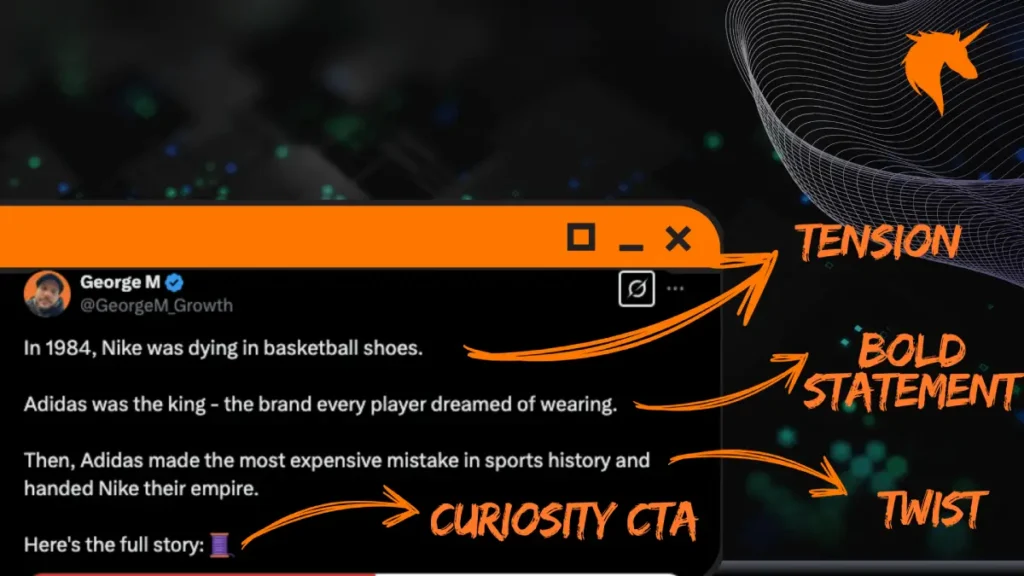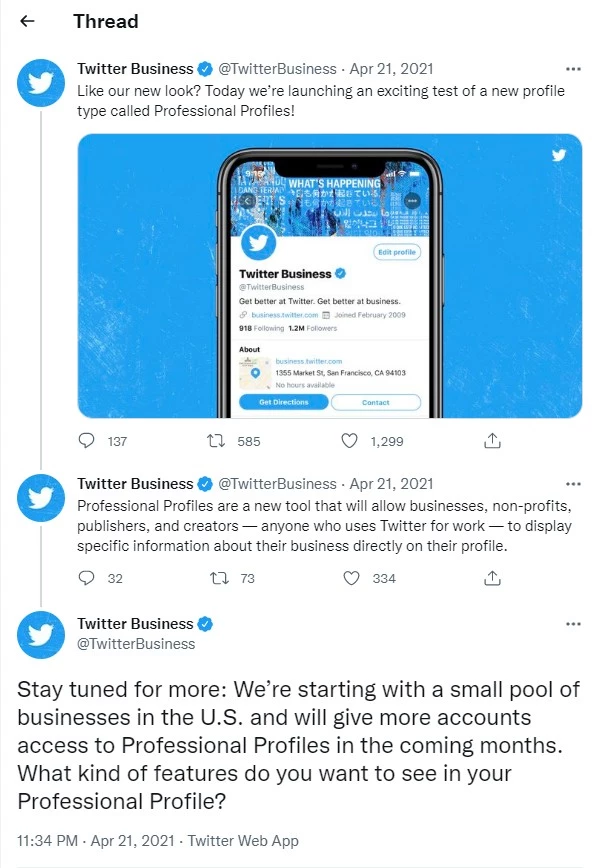
Most people write threads no one reads.
Not because the content sucks—
But because the structure does.
This post gives you the exact thread template that top creators use in 2025 to go viral, build authority, and grow fast.
It helped us grow 25K+ followers in a few months.
Now it’s yours.
Why Threads Still Work in 2025

Twitter’s algorithm rewards time-on-post—the longer someone stays on your content, the more reach it gets.
Threads drive that better than anything else.
They hook attention, hold it with storytelling, and signal quality to the algorithm.
Even Elon confirmed that X boosts content that maximizes “unregretted user seconds”—a fancy way of saying: stuff people actually read and enjoy (source).
For solo brands, threads let you teach, explain, and stand out.
They build authority, not just opinions, by showing depth, not fluff.
Bottom line?
Threads still work.
They’re the best format to grow your following and bring authority..
The Twitter Thread Template
Writing a thread that performs isn’t just about dumping thoughts into bullets.
It’s an art—but one you can reverse-engineer.
After analyzing hundreds of high-performing threads across niches, we found almost every viral post follows the same structure:
Hook → Context → Story Arc → Lesson → CTA
Here’s the exact template for you to copy and paste:

This formula gives your ideas structure, flow, and emotional payoff—all the ingredients the algorithm (and humans) reward.
Once you master this, you’ll stop guessing and start creating threads that actually grow your audience.
Tweet 1: The Hook

If your first tweet doesn’t hook attention—nothing else matters.
In 2025, the best creators don’t just write hooks. They engineer them.
Here’s the proven 4-part formula top accounts use to stop the scroll:
- Bold Statement – Surprise them. Shock them. Make a claim they have to understand.
- Tension – Highlight a struggle or pain point your audience deeply relates to.
- Twist – Flip the script. Offer a surprising insight or unexpected shift.
- Credibility – (Optional) Show receipts—growth, stats, proof that builds trust.
Then end with an open loop or curiosity-driven CTA.
“I hit 50K followers in 90 days.
But I posted less to do it.
Here’s the framework I used—so you don’t waste 6 months like I did: 🧵”
Great hooks are short, punchy, and impossible to ignore.
They don’t just get views—they get followers.
Tweets 2–3: Context
Once the hook grabs attention, the next job is to anchor the reader.
Use Tweets 2–3 to quickly set the scene:
- Who is involved?
- What is happening?
- Why should anyone care?
You’re not writing a history lesson—just enough detail to pull the reader deeper.
“In 2011, EA launched Origin—trying to kill Steam and own 100% of game revenue.
But it backfired. Valve didn’t just survive—they won.”
These tweets build tension and tell the reader:
“This is going somewhere—keep reading.”
Tips:
- Keep it skimmable (2–3 lines max)
- Use proper nouns to anchor the story (names, dates, platforms)
- Avoid fluff or detours—this isn’t the climax, just setup
Think of it like a Netflix intro:
Set the stage fast—before people bounce
Tweets 4–9: The Story
This is the heart of your thread. You’ve hooked them—now deliver.
Use these tweets to unpack the drama, insight, or transformation. Each one should move the story forward, reveal something new, or offer a clear takeaway.
Keep it tight: short sentences, 2–4 lines max, no fluff.
Use cliffhangers to keep readers scrolling:
“EA pulled their games from Steam and forced players onto Origin.
But it backfired.
Hard.”
“Gamers revolted.
Steam kept growing.
And EA’s plan started to fall apart.”
You can mix in screenshots, data, or frameworks—anything that adds weight and keeps attention locked.
Don’t just narrate what happened. Show why it mattered.
Tweet 10: The Lesson
This is where it all clicks. You’ve told the story—now make it matter.
Boil down the takeaway into a simple, memorable insight. Use short lines and strong phrasing. Think: something they’d screenshot or quote.
Examples:
“EA chased control.
Valve earned trust.
Trust scales.”
Or:
“Big moves don’t win by default.
Smart ones do.”
Leave them thinking. This is the line that makes the thread feel worth reading.
Tweets 11–12: The CTA
This is where you connect the story to your brand or offer.
You’ve delivered value—now guide the reader to the next step.
This is the art: even a generic story can lead to your offer if the lesson aligns.
Use this space to pitch without sounding salesy. Anchor it in what you just taught.
Examples:
“That’s the game we teach.
BuildSolo helps solo founders grow with real startup tactics—no fluff.
Follow @BuildSolo or tap the link in bio.”
Or:
“Want to master Twitter?
The X Growth Blueprint breaks it all down—step by step.
It’s how I grew from 0 → 25K followers.”
Keep it casual. Confident. Aligned with the story they just read.
Bonus Tips to Boost Thread Performance

Want your thread to actually perform? Here’s what separates good from great:
- Write what your audience cares about.
Don’t chase trends. Solve problems. Share hard-earned lessons. - Make it interesting, not just “helpful.”
If it’s not surprising, emotional, or counterintuitive—it won’t hook. - Keep tweets short.
Aim for under 250 characters.
Under 200 is even better.
Short tweets = more skims, more shares. - Use cliffhangers every 1–2 tweets.
Never let the scroll die. Leave a reason to keep going. - Vary your sentence rhythm.
Like this:
“This is the rhythm of a thread.
It flows.
It punches.
It pauses.
It makes you want to read more.”
(Thanks, Gary Provost.)
- Add specific, believable data.
Don’t just say “I grew fast.”
Say: “I gained 12,487 followers in 61 days.” - Add value visually.
Use clean graphs. Screenshots. Memes. Even a well-placed emoji helps.
8. End clean.
No spammy CTAs.
Keep it simple.
Confident.
Aligned with the thread’s value.
Swipe the Template (Copy-Paste)
1. [Big bold hook]
2. [Set the stage]
3. [Raise the stakes]
4–9. [Unfold the drama or insights]
10. [Punchy lesson]
11. [Soft CTA]
12. [Final CTA or engagement ask]
This is just one slice of the X Growth Playbook—a complete system built like a startup engine.
Inside, you’ll get growth mechanisms, proven templates, and weekly task flows to turn Twitter into your #1 customer acquisition channel.
If you’re ready to grow with precision, grab the playbook now.

George Mastorakis is a digital marketer with 12+ years of experience in building and growing online businesses. From affiliate SEO sites and CPA funnels to agency work and leading growth at Synthesys from $0 to $1M ARR, he’s done it all. Today, he helps solo founders build a personal brand and scale their businesses using startup growth tactics he’s refined through years of hands-on experience.


Leave a Reply